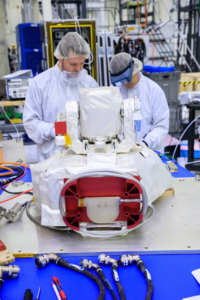Lasers on the Moon and Beyond
Introduction
Humans will soon be set to return to the Moon, equipped with photonics technology that will provide communications capabilities beyond imaginable 54 years ago during the first Moon landing.
From the early days of laser technology, researchers recognised that light beams could significantly surpass the information carrying capacity of RF and microwave radio transmissions. The light wavelengths are considerably shorter than radio signals wavelengths, enabling the transmission of optical signals at data rates exceeding one terabit per second.
For decades, lasers have been integral to data communications, reading CDs and DVDs, scanning barcodes at checkout, and transmitting signals through the fiber optic network that form the internet’s foundation. Now, free-space optical communications—in which laser transmitter light is sent through open air or space—are expected to become critical for future space missions targeting the Moon and eventually, Mars.

The O2O
NASA’s Artemis II crewed mission to the Moon is scheduled to launch at the end of 2024, featuring a next-generation communications system designed to connect the crewed Orion spacecraft with mission control on Earth. The system is known as the Orion Artemis II Optical Communications System (O2O), it operates at 260 megabits-per-second, delivering multiple streams of 4K resolution video from the Moon to Earth and supporting various mission-critical communications.
Prior to the Artemis mission, NASA relied on the radio systems of Tracking and Data Relay Satellite System (TDRSS) and Deep Space Network (DSN) for data exchange between Earth and mission spacecraft. However, the O2O laser communications system will transmit terabyte-sized data chunks in a single transmission, offering NASA and other entities a wealth of critical mission information. The light from Orion’s laser transmitters will be directed towards Earth and captured by ground-based stations, which will subsequently relay the data received to the mission centre.
“While 260 megabits-per-second may not seem significant in today’s world of terabit-per-second speeds,” stated Randy Giles, former ISS National Lab Chief Scientist, and Optica Senior Science Advisor. “The O2O optical link can be the length of 400,000 kilometers, passage through Earth’s turbulent atmosphere, and the absence of optical repeaters to strengthen or refocus the optical beam along the way, making 260 Mb/s a remarkable achievement in engineering.”
“Components on board O2O consist of an optical module built around a 4-inch telescope and two gimbals to direct the telescope towards ground terminals on Earth,” explained Professor Daewook Kim from the University of Arizona. “The O2O will facilitate the transmission and reception of procedures, pictures, flight plans, and serve as a link between Orion and mission control on Earth. This is an exciting time for our optical astronomy community.”
“At CACI, we have been ensuring secure communications across a range of orbits and missions,” stated Matthew Reichert, Optical Engineer at CACI. “Our American-made optical communications technology converts data to and from laser beams for communication onboard satellites for the Department of Defense and human spaceflight capsules, including NASA’s Artemis II. As a trusted provider of low-risk, reliable optical communications technology, CACI has designed, manufactured, and tested the modem module for the O2O terminal to meet NASA’s stringent performance, environmental, and safety standards. We are very proud to support NASA and contribute to America’s return to the Moon.”
Conclusion
A few years after the lunar mission, another Orion Spacecraft will journey far beyond the Moon.
During its solo voyage through the abyss of deep space, optical data links spanning millions of kilometers will connect the crewed vessel to Earth, drastically enhancing mission safety, crew morale, and the science capabilities. With the support of this photonics technology, the astronauts’ first steps on Mars will be an unforgettable show, captivating audiences on Earth like never before.
Copyright 2024 Optica. All Rights Reserved.
Contact us via email for more information.


